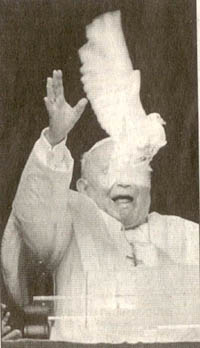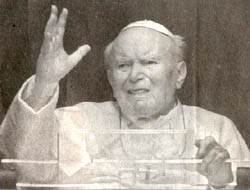 |
NEWS: April 6, 2005
Bird’s Eye View of the News
Atila Sinke Guimarães
SOMETHING IS FISHY ABOUT THE DEATH OF JOHN PAUL II - News about the Pope’s funeral is flooding the media. One point, however, is not clear to me. I have not found a sufficient explanation in the Vatican reports about what was really the cause of John Paul II’s death.
We all know that he had Parkinson’s disease, which very rarely is fatal. We all know that he caught a cold, which also is very rarely fatal. So, he caught a cold and was packed off to the hospital to ease his breathing. It was presented as a question of comfort, not of necessity. After a few days he returned to the Vatican triumphant in a popemobile. Up to this point, the picture is believable. From then on, it becomes blurry.

On January 30, the Pope appeared happy but not in his best form - L.A. Times, January 31, 2005
|
After just several days in the Vatican, something happened and he urgently needed to be reinstalled in the hospital and subjected to a tracheotomy. What happened? No satisfactory explanation. Just an insistence on the same point: he had a cold and a light respiratory problem. Why the need for such a radical procedure as a tracheotomy, which had a side consequence of preventing him from speaking? No explanation.
At Gemelli Hospital, according to the official reports, he recovered. This time he returned to the Vatican in an ambulance. The news circulated that John Paul II was fine again. But on Wednesday, March 23, he appeared at the window of his apartment with an angry, acrimonious face, tried to speak, but was not able to do so. It was his final appearance. Suddenly the rumor began to spread that the Pope's health was rapidly declining. News reports said that the doctors could not do anything more for him. Also, that he would not be kept alive with the help of tubes, because this was his choice. On April 2 he died. Everything happened with too much haste and confusion. How can a simple cold in a man with a known stamina develop so quickly into a life-and-death situation? No explanation was given.
I was waiting for the report of the autopsy traditionally done on Popes' bodies and the official declaration of the causa mortis [cause of death]. To date I have found no mention of an autopsy. The official death certificate with the medical statement, which I took from the Vatican website and translated from Italian, is the following:
Declaration of Death of His Holiness John Paul II
I certify that His Holiness John Paul II (Karol Wojtyla), born in Wadowice (Krakov, Poland) on May 18, 1920, living in Vatican City, citizen of the Vatican, died on April 2, 2005 at 9:37 p.m. in his apartments in the Vatican Apostolic Palace (Vatican City) as a result of:
- Septic shock;
- Irreversible cardio-circulatory collapse.
In a person subject to:
- Parkinson's disease;
- Previous episodes of acute respiratory insufficiency and subsequent tracheotomy;
- Benign enlarged prostate complicated by urinary infection;
- Hypertensive and ischemic heart disease.
Verification of the death was made by means of heart-monitoring equipment for more than 20 minutes.
I declare that the causes of death, according to my knowledge and conscience, are those indicated above.
Vatican City, April 2, 2005.
The Director of the Directory of Heath & Hygiene of the Vatican City State.
Dr. Renato Buzzonetti.
I am not a doctor, nonetheless, let me try to analyze this official declaration applying the simple criteria of good sense. I will willingly correct my comments should a competent physician forward to me a convincing explanation. For the sake of clarity, I will divide my analysis into items:

At his last public appearance, he looked very sick and angry - L.A. Times, March 25, 2005
|
1.In this document there is no mention of an autopsy. Therefore, I assume none was made. I recall that after the strange death of John Paul I, an autopsy of his body was forbidden, breaking an old tradition. This suspicious prohibition roused all kinds of stories that he had been poisoned. Articles and books have been written on this topic, and until today the discussion is not closed. If, in fact, there was no autopsy on the body of John Paul II, then what was the reason? A tradition had already been established to carry out this procedure on the bodies of Popes. Why didn’t the Vatican maintain this wise method of confirming the cause of death to provide the needed transparency for the Catholic faithful regarding John Paul II’s death?
2.The doctor stated that “irreversible cardio-circulatory collapse” was a cause of his death. However, this statement does not seem very precise. Actually, anyone who dies – whether he is struck by a car or drinks poison – suffers “irreversible cardio-circulatory collapse” since his heart stops working, but this is not the cause of death; it is a consequence of something else. In my opinion, this statement would only apply to a person who would have died from a heart attack. Was this the case of John Paul II? If so, why wasn’t it reported? If not, why this ambiguous generalization? Confusion.
3.I read an unsigned interpretation of the death certificate on the Internet. It states that an “irreversible cardio-circulatory collapse” means a collapse of the blood vessels (Toronto’s 24 Hour Newsource, April 3). So, if this is the case, then the problem was not that the heart stopped, but rather that the vessels didn’t allow the blood to circulate. Why? Were the veins and arteries so infected that they could no longer carry out their functions? Was there a general putrefaction of JPII’s body? Caused by what? Or were the veins and arteries obstructed by some coagulation? What kind of stroke would it be? Again, there are ommissions.
4.The report also affirmed that he died from “septic shock.” Period. What does this mean? According to what I read, “septic shock” translates in simple lay terms to blood poisoning (Ibid.). Let me suppose that this would be true. The cause of this blood poisoning still needs to be explained. Would it be the inflammation in the urinary tract that degenerated into a general poisoning? There is not a word in the official declaration that permits one to induce this conclusion. On the contrary, the document states that there was benign prostate dilatation, which lead one to conclude that the mentioned urinary tract infection was not something unusual or untreatable. Anyway, if that infection spread rapidly in a process of a general putrefaction, why wasn’t this stated by the doctor and reported by the Vatican organs? Again, it is an omission that stimulates suspicions.
5.The last part of the document does not seem to offer anything new that would provide satisfactory answers to my questions.
The conclusions seem simple:
- There is no explanation why the traditional autopsy of John Paul II was avoided;
- The alleged causa mortis of John Paul II does not seem to stand up to an elementary critique.
In short, the reasons presented are not convincing.
After he died, instead of clearly and openly explaining the cause for his hasty death and providing all the needed data, the Vatican raised a thick curtain of smoke around his death. A curtain of praise and eulogies, but, anyway, a curtain of smoke. The media followed the same path by creating an enormous fanfare over his life. I am not discussing here if all this hue and cry is appropriate. I am just asking if a part of it was not intended to deviate public attention from the real cause of his death.


Related Works of Interest
|
News | Home | Books | CDs | Search | Contact Us | Donate

©2002- Tradition in Action, Inc. All Rights Reserved
|
 |
|